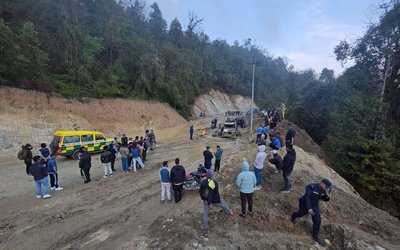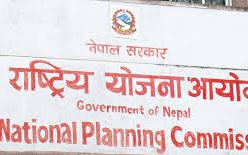
With a million vile of Covid-19 vaccine, which was gifted with generosity by Nepal’s southern neighbor India, Nepal is among a few countries to have launched COVID-19 vaccination campaign comparatively earlier. However, Nepal is unable to accelerate the pace for vaccination.
As Nepal is receiving additional 2.2 million vaccines from and China has offered 500000, there are over 3 million vaccines in the process of coming to Nepal, enough to vaccinate over 15 percent population. Nepal now needs to work to accelerate the process of vaccination to contain the second wave.
Under its neighbor-first policy, India has already expressed its commitment to help Nepal’s campaign by providing additional vaccination. Given the circumstances, Nepal is in a good position to have vaccines.
“Very important priorities now, after vaccination of health workers to front-line service providers in institutions, are banks, airports, offices and senior people, aged 65 and over, and those under 65 with health conditions,” writes Dr. Badri Raj Pandey in his face book.
Invention and successful trials and eventually the arrival of one million doses of COVID-19 vaccine from India have been a big sigh of relief to the Nepali people panicked for a year after the outbreak of the deadly virus.
The much-awaited COVID-19 vaccine finally arrived in Nepal in the form of grant from the southern neighbor in the last week of January and the first phase of nationwide vaccination drive began on January 27 and concluded on February 6.
During the 10-day first phase drive, frontline workers, mostly the health workers, received the first jab. According to the Ministry of Health and Population, in 10 days, 184,745 got the jabs across country.
Second Phase of vaccination must begin soon for those above 55 and people in the second frontline who work in close proximity with customers like public servants, teachers, bankers, security personnel, hotel and restaurant employees, drivers, conductors etc.

This will help in getting the economy back.
We have 8 lakhs vaccines coming from India and are expecting another 23 lakhs from WHO.
Government authorities, health experts and workers are found to be excited with the availability of the vaccines much before the expected time. However, people in general and even a few health workers seem lacking confidence on the vaccines. It is evident from the fact that Nepal could cover only less than half of the targeted number of people in the first phase of vaccination.
Studies are showing the second dose given at 3 months is better than 1 month.
For a successful vaccination drive, people’s trust towards the vaccine is necessary. But it was found lacking in Nepal.
Dr. Shyam Raj Upreti, Coordinator of the COVID-19 Vaccine Advisory Committee at the MoHP, said that the first vaccination drive in Nepal could not be considered successful in terms of coverage.
“As the 10-day immunization campaign ended, the number of vaccinated people did not reach 200,000 while our target was to inoculate 430,000 front line health workers in the first phase,” he added.
He gives two reasons for failing to meet the target.
“Firstly, the immunization booths across the nation have been set at the district headquarters thereby barring the access of health personnel working in the rural areas,” said Dr. Upreti, adding, “Secondly, we somewhat failed to generate awareness about the importance of vaccination to overcome the pandemic prior to launching the campaign.”
“I think no one has expected that the vaccination campaign will take place this soon in Nepal,” said Dr. Rabindra Pandey, a public health expert. “This is why it was difficult for many people to take it.”
As a few health workers are exposed to misinformation and rumors on vaccine, more awareness is still needed to build trust and confidence in vaccines, said Dr. Pandey.
During the inoculation period of the first phase drive, we address vaccine hesitancy and tackle misinformation on the side effects, now we hope more confidence will be developed among the vaccine receivers in the second phase, added Dr. Jhalak Gautam, Chief of Child Health and Vaccine Department at the Department of Health.

It is very important to understand that even if some side effects are noticed after immunization, people must take it easily, as it is a sign that the shot is working,” said Gautam.
Although some side effects were seen among the jab receivers, no any severe case has been reported during the first phase campaign, he added.
The Ministry of Health and Population (MoHP) has already started preparations for the second phase of the vaccination drive.
The surplus COVID-19 vaccines from the first phase will be used for those falling in priority in the second phase of the inoculation.
Dr. Upreti said that plans were being made to vaccinate people aged above 55 years, as they fall in high risk group of COVID-19.
“We had planned to vaccinate around 430,000 frontline health workers in the first phase. As the number of people getting vaccinated is less than 200,000, the remaining doses of vaccines will be used in the second phase of our vaccination drive,” said Dr. Jageshwor Gautam, spokesperson at the MoHP.
Dr. Gautam added, “The ministry has aimed to inoculate 30,000 government health workers, 60,000 female health volunteers, and 250,000 health workers registered in Nepal Health Council.”
However, as most of the health workers registered at the Council have fled abroad for employment or studies, the number of people receiving vaccines here is lesser than our target, he said.
Dr. Gautam said that along with the front-line health workers, the employees of the immigration offices, customs offices, Tribhuvan International Airport and senior citizens of old age homes were also being inoculated.
China has pledged to provide 500,000 doses of vaccines in grant. Similarly, Nepal will be receiving 2,256,000 doses of COVID-19 vaccines under the COVAX facility, according to the ‘Interim Distribution Forecast’ published by COVAX.
COVAX, co-led by Global Alliance for Vaccine and Immunization (Gavi), informed that the UN Health Agency would start the distribution of vaccines by the end of February.
“For AZ/SII (AstraZeneca/Serum Institute of India) and AZ (AstraZeneca) indicative distribution, delivery is estimated to begin as of late February,” read the forecast.
‘Covishield’ developed jointly by the Oxford University and AstraZeneca and manufactured by the Serum Institute of India will be provided to Nepal under the facility.
“We are receiving ‘Covishield’ vaccine under COVAX program which is a preferred vaccine for us as the existing storage and transportation infrastructure used in the nation to immunize children can be brought in use,” said Dr. Jhalak Gautam.
“It will not be a problem for us to store the vaccines, as we have infrastructure suitable for it, the main thing is prioritized people must come forward and get the jab with trust and confidence,” added Dr. Gautam.
The Covishield vaccines can be stored at a temperature between two to eight degrees Celsius. The MoHP is also planning to procure four million doses of the COVID-19 vaccine from India in the final phase.
The first phase of the vaccination drive was conducted from 201 booths in 77 districts. Frontline workers including health and sanitation workers were inoculated based on priority.
According to the statistics provided by Ministry of Health and Population, of the total number of people that received the jab - 24,224 were from Province 1; 25,637 from Province 2; 63,308 from Bagmati Province; and 18,472 from Gandaki Province. Similarly, 28,941 received the vaccine in Lumbini Province; 9,420 in Karnali Province, and 14,855 in Sudurpaschim Province.
As Nepal has successfully handled the first phase of Covid-19 vaccination campaign, Nepal needs to accelerate the pace of administering the Covid vaccine. Given the assurance coming from Nepal’s friends and neighbor India,
Don’t Spread Unnecessary Rumor against Vaccine: Dr. Badri Raj Pandey
I took Covid vaccine and I felt no uneasiness. Vaccines cause minor complications like swelling the place where vaccine is administered, headache, tiredness, muscle pain and sometime fever 37.8. I was prepared for all these reactions. However, nothing happened to me. Even if that had occurred, I would have used Paracetamol and I would be alright in a few days. Such symptoms can be seen till 3 days of administering vaccine. Unnecessary rumors regarding using the vaccine creates panic on the minds of the people regarding the Covid vaccine. One has to understand that there is no guarantee that the vaccine is 100 safe. The main thing is don’t panic that it will have adverse effects.
The currently administered Oxford AstraZeneca Vaccine can reduce 76 percent of risk of infection of covid-19. For its efficacy one has to wait for 3 weeks. One has to take the second doze within 3 months. If it is used massively, it will help to contain virus.
One should take the vaccine in confidence if he or she is taking aspirin everyday and over 65 years of age. Otherwise why should I have taken it. I want to congratulate Indian government for supplying the Covid vaccine in SAARC Region. Why has Pakistan not received it? One has to hail Nepal government for starting the vaccination campaign erlier.
My humble request is to all, to go to vaccine center, to get the vaccine administered. However, one has to wear masks, maintaining social distance and should follow health protocols, following the vaccine administration.
(From Facebook)
- NEPAL-THAILAND: Joint Business Council
- Apr 13, 2025
- BIMSTEC SUMMIT: Nepal’s Stand
- Apr 11, 2025
- IME GROUP: Expands Into Paper Industry
- Mar 24, 2025
- CPN UML: Instigated By India
- Mar 23, 2025
- ADB’S CHIEF ECONOMIST: Nepal Reduces Poverty
- Mar 11, 2025















